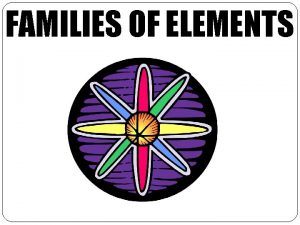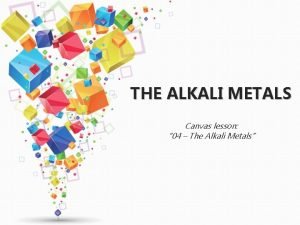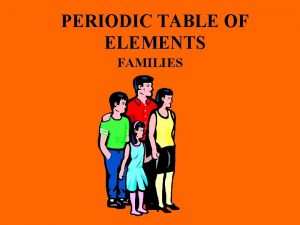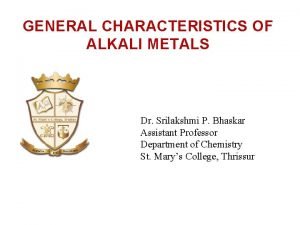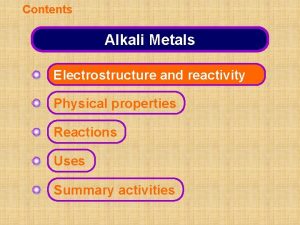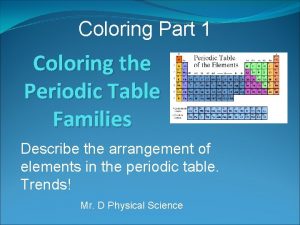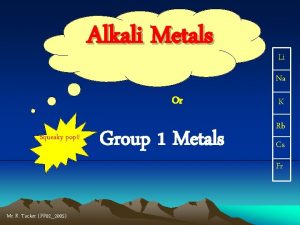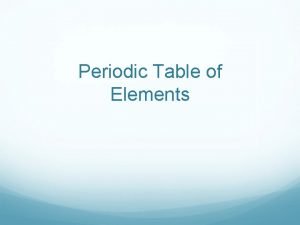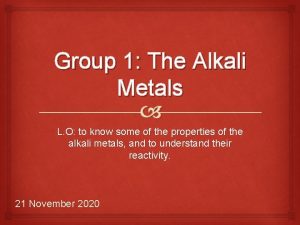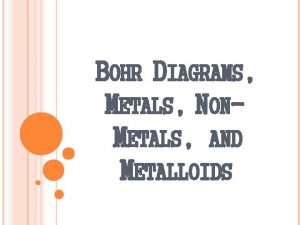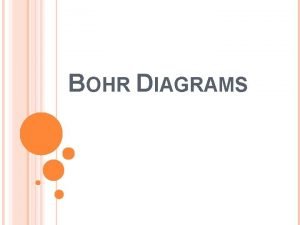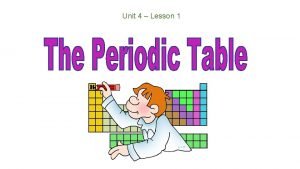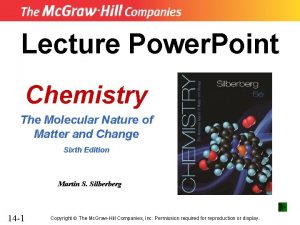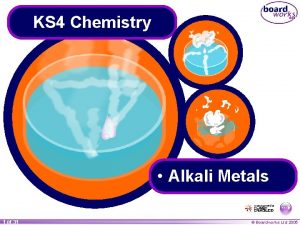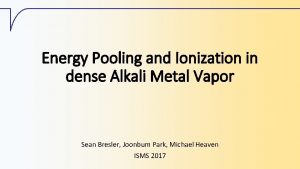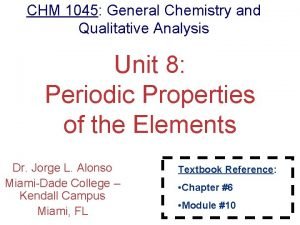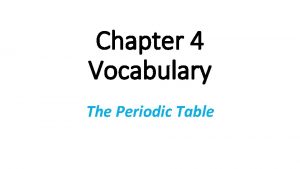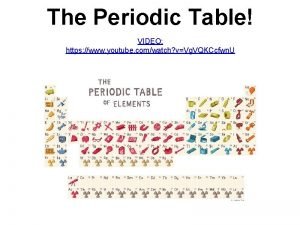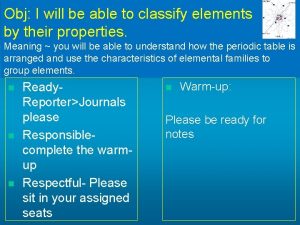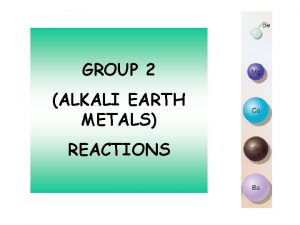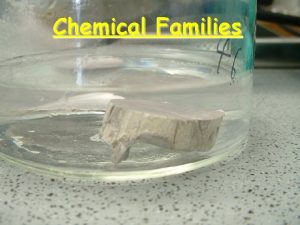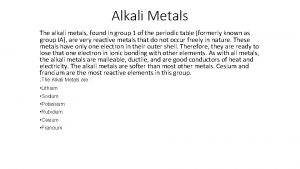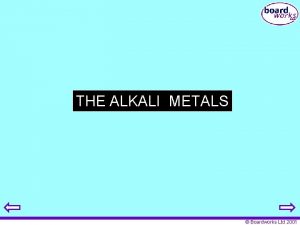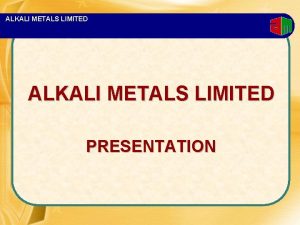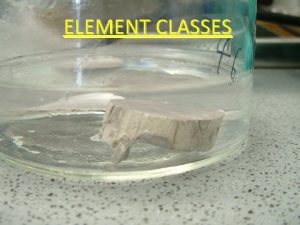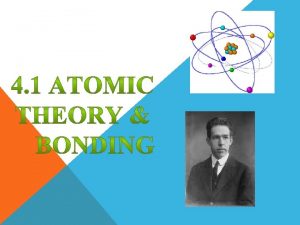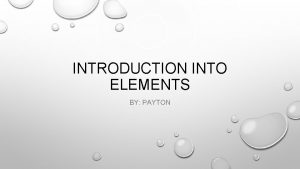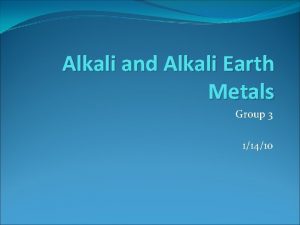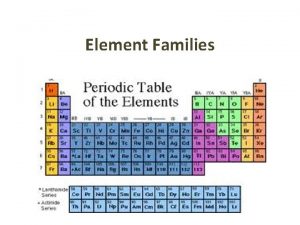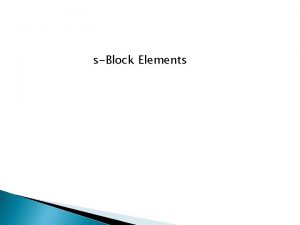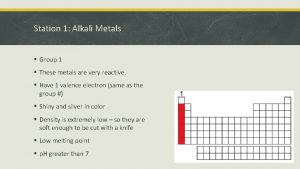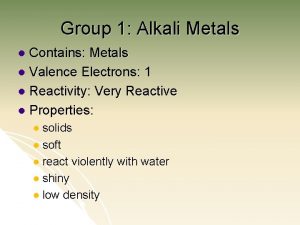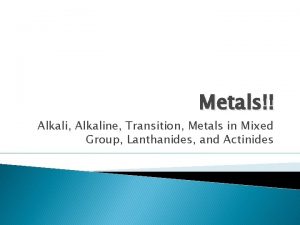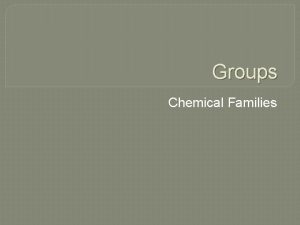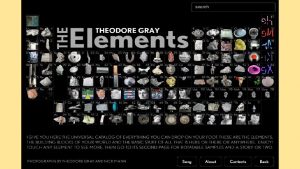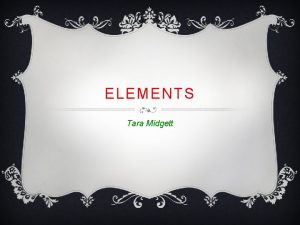FAMILIES OF ELEMENTS GroupsFamilies Group 1 ALKALI METALS























- Slides: 23

FAMILIES OF ELEMENTS


Groups/Families Group 1: ALKALI METALS Group 2: ALKALINE EARTH METALS Group 3 -12: TRANSITION METALS (Inner transition metals- rare earth elements) Groups 13 -18: NON-METALS (mostly) Group 17: HALOGENS Group 18: NOBLE GASES

v The periodic table contains all the known elements in order of increasing atomic number. v Elements of atoms with similar structures have similar properties. Therefore, they are positioned close to each other. v Elements can be divided into metals and nonmetals forming large groups.

v. There is consistency in chemical properties of the elements. This happens because the electrons in atoms are arranged in shells. v. Each shell holds a certain number of electrons. v. All elements with the same number of electrons in the outermost shell behave in similar ways. (Same GROUPS) v. Elements will combine with other elements in order to complete/fill their outer shells. When elements combine, (usually a metal & nonmetal) a compound is formed.

ELECTRON CONFIGURATIONS These are diagrams that show energy levels for electrons surrounding the nucleus of a particular atom. EXAMPLE: LITHIUM 3 Li 6. 941 Element box • 3 P 4 N • Bohr Model • 3 P 4 N 2 1 OR Li Bohr Dot diagram (Shells)

Circle your level of understanding of these concepts: 1 2 3 4

Metals v. Most of the elements are classified as metals v. Metals usually have 3 or less electrons in their outer energy level. Therefore, metals give away electrons (or lose e-) when forming compounds v. They usually have a luster or shine v. Most metals are good conductors of heat and electricity v They are malleable and ductile

ALKALI METALS: GROUP IA (1) (EXCEPT HYDROGEN) These elements: 1. contain one electron in their outer energy levels. 2. are the most chemically active of all the metals. They are so close to having a full shell that they want to bond with other elements and lose that electron; this makes them very reactive metals. 3. Most compounds are white. Ex: Table salt

ALKALI METALS: GROUP IA (1) (EXCEPT HYDROGEN) These elements: 4. 5. 6. are shiny, good conductors, malleable, and light weight. are never found in pure form in nature. react violently with oxygen and water. Which is why these metals are stored covered in oil.

Alkaline Earth Metals: Group IIA (2) These elements: 1. contain two electrons in their outer energy levels. nd 2. are the 2 most reactive metals. 3. They form compounds by losing electrons. Some react with water.

Alkaline Earth Metals: Group IIA (2) These elements: 4. have the same metallic properties as the alkali metals, but are slightly less reactive. 5. Magnesium and calcium are most common compounds found in nature (animals & plants).

TRANSITION METALS: GROUPS III – XIIB (3 -12) These elements: 1. have a lot of electrons and distribute them in different ways than the other elements. 2. are able to put up to 32 electrons in their second-to-last shell. 3. contain one or two electrons in their outer (last) energy levels.

Transition Metals: Groups III – XIIB (3 -12) These elements: 4. can lose one or both of these electrons. 5. can use the two outermost shells/orbital to bond with other elements. They can also share electrons when forming compounds.

6. 7. 8. 9. Transition Metals: Groups III – XIIB (3 -12) have low ion charges. are usually colored. are great conductors, very hard, malleable, and shiny with high melting and boiling points. form alloys that are mixtures composed of 2 or more metals or a metal and a nonmetal.

Circle your level of understanding of these concepts: 1 2 3 4

Non-Metals v. Non-metals tend to vary more from element to element. v. Non-Metals usually have 5 or more electrons in their outer energy level. Therefore, non-metals steal electrons (or gain e-) when forming compounds v. They usually gases at room temp. v. The few solids are dull & brittle v. Non-metals are poor conductors of heat and electricity v

Group XVIIA (17): Halogens These elements: 1. contain seven electrons in their outer energy levels. 2. form compounds by gaining an electron. 3. have the trait of combining with many different elements since they are only missing one electron. Bond with metals and element in Group 1. 4. are reactive. Fluorine is the most reactive, and then it decreases as you go down.

GROUP XVIII (18): NOBLE GASES These elements: 1. contain eight electrons in their outer energy levels. 2. last energy levels are full so they usually do not bond with other elements, especially in nature. 3. are nonreactive. 4. become more rare as you move down the group.

Circle your level of understanding of these concepts: 1 2 3 4

Synthetic Elements v. Elements with atomic numbers 43, 61, 93 and above are synthetic elements. v. They are produced in nuclear reactions. v. All of these elements breakdown into other elements.

ALLOYS • Alloys have properties that pure metals composing them do not have. Example: • An alloy of iron and chromium does not rust, but iron does. • Steel is an alloy composed mainly of iron and carbon.

Circle your level of understanding of these concepts: 1 2 3 4
 Group iia elements are called
Group iia elements are called Big families vs small families
Big families vs small families Melting point of alkali metals
Melting point of alkali metals Characteristics of alkali
Characteristics of alkali General characteristics of halogens
General characteristics of halogens Order of mobility of alkali metal ions
Order of mobility of alkali metal ions General characteristics of alkali metals
General characteristics of alkali metals Periodic table color coded by families
Periodic table color coded by families Where is the most reactive elements on the periodic table
Where is the most reactive elements on the periodic table Fun facts about alkali metals
Fun facts about alkali metals Elements in group 1
Elements in group 1 Alkali metals video
Alkali metals video Alkali metals bohr diagrams
Alkali metals bohr diagrams Bohr diagram for carbon
Bohr diagram for carbon Nh fl mc lv ts og
Nh fl mc lv ts og Alkali metals reacting with water
Alkali metals reacting with water Lithium and oxygen word equation
Lithium and oxygen word equation Alkali metals periodic table
Alkali metals periodic table Alkali metals reacting with water
Alkali metals reacting with water Alkali metals periodic table
Alkali metals periodic table Youtube brainiac alkali metals
Youtube brainiac alkali metals Common elements
Common elements Metal and water reaction
Metal and water reaction Periodic table metals and nonmetals
Periodic table metals and nonmetals
